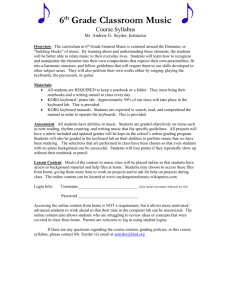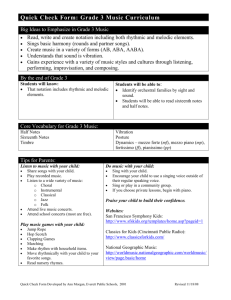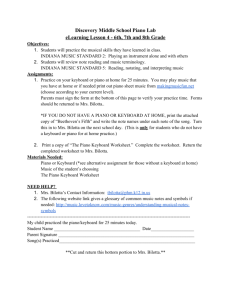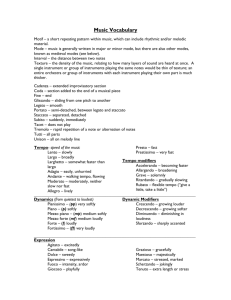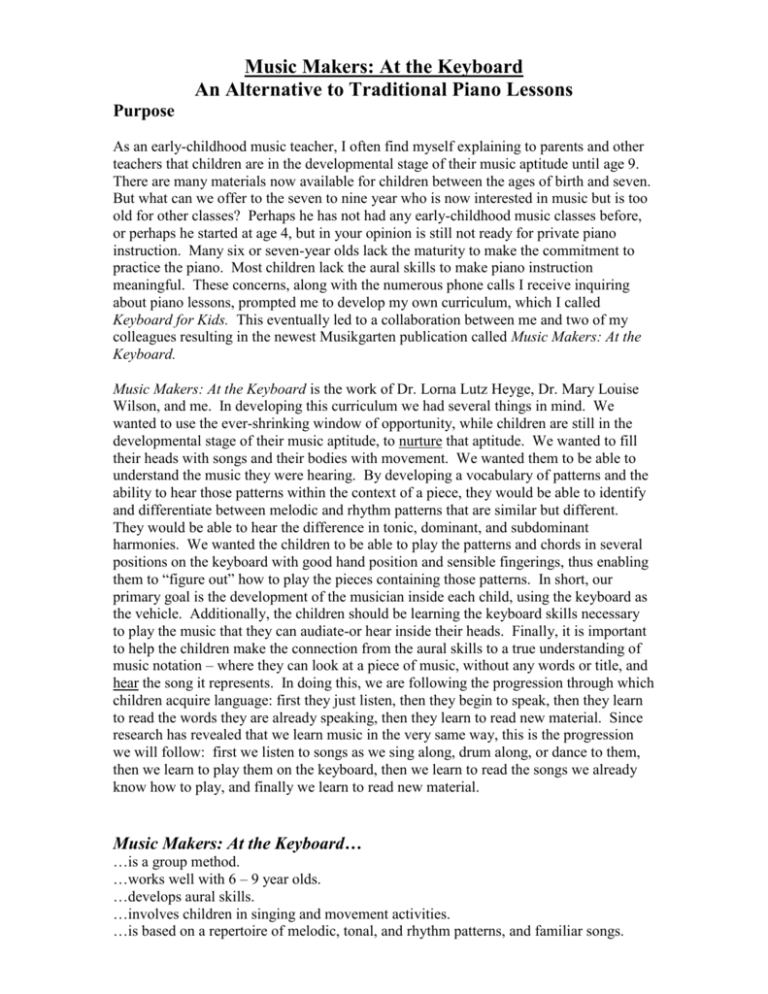
Music Makers: At the Keyboard
An Alternative to Traditional Piano Lessons
Purpose
As an early-childhood music teacher, I often find myself explaining to parents and other
teachers that children are in the developmental stage of their music aptitude until age 9.
There are many materials now available for children between the ages of birth and seven.
But what can we offer to the seven to nine year who is now interested in music but is too
old for other classes? Perhaps he has not had any early-childhood music classes before,
or perhaps he started at age 4, but in your opinion is still not ready for private piano
instruction. Many six or seven-year olds lack the maturity to make the commitment to
practice the piano. Most children lack the aural skills to make piano instruction
meaningful. These concerns, along with the numerous phone calls I receive inquiring
about piano lessons, prompted me to develop my own curriculum, which I called
Keyboard for Kids. This eventually led to a collaboration between me and two of my
colleagues resulting in the newest Musikgarten publication called Music Makers: At the
Keyboard.
Music Makers: At the Keyboard is the work of Dr. Lorna Lutz Heyge, Dr. Mary Louise
Wilson, and me. In developing this curriculum we had several things in mind. We
wanted to use the ever-shrinking window of opportunity, while children are still in the
developmental stage of their music aptitude, to nurture that aptitude. We wanted to fill
their heads with songs and their bodies with movement. We wanted them to be able to
understand the music they were hearing. By developing a vocabulary of patterns and the
ability to hear those patterns within the context of a piece, they would be able to identify
and differentiate between melodic and rhythm patterns that are similar but different.
They would be able to hear the difference in tonic, dominant, and subdominant
harmonies. We wanted the children to be able to play the patterns and chords in several
positions on the keyboard with good hand position and sensible fingerings, thus enabling
them to “figure out” how to play the pieces containing those patterns. In short, our
primary goal is the development of the musician inside each child, using the keyboard as
the vehicle. Additionally, the children should be learning the keyboard skills necessary
to play the music that they can audiate-or hear inside their heads. Finally, it is important
to help the children make the connection from the aural skills to a true understanding of
music notation – where they can look at a piece of music, without any words or title, and
hear the song it represents. In doing this, we are following the progression through which
children acquire language: first they just listen, then they begin to speak, then they learn
to read the words they are already speaking, then they learn to read new material. Since
research has revealed that we learn music in the very same way, this is the progression
we will follow: first we listen to songs as we sing along, drum along, or dance to them,
then we learn to play them on the keyboard, then we learn to read the songs we already
know how to play, and finally we learn to read new material.
Music Makers: At the Keyboard…
…is a group method.
…works well with 6 – 9 year olds.
…develops aural skills.
…involves children in singing and movement activities.
…is based on a repertoire of melodic, tonal, and rhythm patterns, and familiar songs.
…prepares a child to succeed in traditional piano lessons.
…leads to true music literacy, enabling the child to “hear what s/he sees” and “see what
s/he hears”.
…follows a careful sequence in teaching the children to read music, including notation
games, mystery songs, and dictation activities.
…provides a solid musical foundation for all subsequent music making.
…is a logical follow-up to early-childhood music classes.
…is a sensible starting place for “beginners” who are too old for early-childhood
offerings.
…enables kids to figure out how to play their favorite songs.
…starts in a five-finger position.
…helps kids to aurally recognize patterns within songs and utilizes solfege as a means of
naming and organizing those patterns.
…begins with a chord approach and encourages kids to figure out the appropriate
accompaniment as they begin to recognize melodic/harmonic relationships.
Observations
Having taught this way for several years there are several things worth mentioning.
Students who practice regularly quickly build a repertoire of songs they can play with
chordal accompaniment in a variety of keys. However, even those who don’t practice
regularly continue to grow musically. They gain more control of their singing voices,
become more beat competent, and they have an ever-expanding vocabulary of patterns
which they can recognize aurally. Music Makers: At the Keyboard students often sing
while they play! As a result, they know immediately when they’ve played a wrong note
or chord, and they’re able to fix it right away. It is as if their hands are being guided by
their voices and ears. Perhaps the most exciting thing is that these children come into my
studio each week chomping at the bit to show me what they can play. Sometimes it is
what we worked on in class, but often it is tune they’ve heard on television or at school.
In my opinion, enabling these children to play anything they can hear is the best
prevention against another generation of piano players who stop playing as soon as they
stop taking lessons. And the aural skills they have learned will serve them well whether
they go on to traditional piano lessons or the school instrumental programs.
Time spent nurturing the musician inside each child is time well spent. Instrumental
skills will take a child only so far, but it is the music inside each child that will motivate
him to master the instrument. Music Makers: At the Keyboard is an alternative to
starting piano lessons prematurely. We have from age 9 until 99 to teach instrumental
skills. What’s the rush?
For more information regarding Music Makers: At the Keyboard call Jill Hannagan of the Hockessin
Music School at 302-239-8281.
Copyright 2001 by Jill Hannagan. All rights reserved. For permission to copy contact the author at hannagasn@udel.edu or at 302239-8281.

